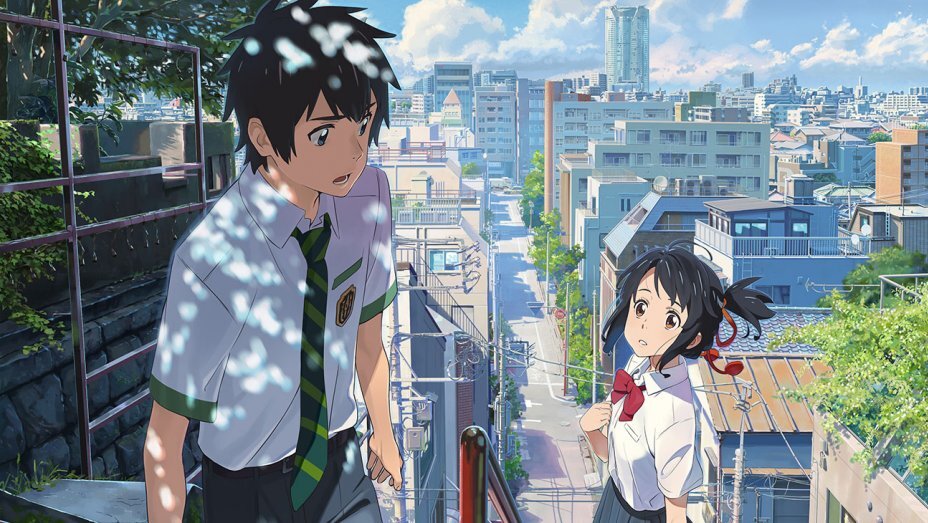Modernity and Tradition in Japan via Makoto Shinkai’s Your Name (2016)
Makoto Shinkai’s animated film Kimi No Na Wa, translated as Your Name, was a critical and commercial hit when it was released in 2016. The film depicts the strange and wondrous journey of two high school teenagers, city boy Taki in Tokyo and countryside girl Mitsuha in rural lakeside Itomori, who are inexplicably swapping bodies with each other. Your Name is currently the highest grossing anime feature of all time, a remarkable mainstream success at the local box office and in its global reception. Such widespread positive attention is rarely seen outside of films made by Studio Ghibli and Hayao Miyazaki, and Your Name has since solidified Shinkai’s position as a leading filmmaker on the animated movie landscape (Fig. 1). The fantastical premise of Your Name’s story, combined with gorgeous naturalistic animation and standout music composition, all play defining roles in the film’s success. However, a central idea that underpins Your Name is the tension between modernity and tradition, informed by postmodern Japan’s sense of cultural loss due to globalisation, termed mukokuseki or nationlessness (Iwabuchi 2002: 28). The music composed and performed by Japanese band RADWIMPS acts in tandem with the aesthetics to shape the movie’s thematic coherence, and to amplify fantastical elements in the animated medium. RADWIMPS’s soundtrack is part of a wider genre of anime music uniquely situated to support animated films on a creative and commercial scale, given Japan’s intersection of high music CD consumption, a thriving music industry, and the prevalent franchising of popular anime elements including soundtracks to fans. With Your Name, I offer an analysis in this post of the opening music, material cultural identifiers, and synthesis of sound elements with visual sequences to interrogate how aural cues inform the recurring mediation of tradition and modernity in the text, and which are integral in drawing the viewer into the animated world.
Your Name evokes culturally specific, nostalgia-driven modes of narration where sound acts as a unifying force. The musical number Yumetōrō 夢灯籠, literally meaning ‘dream lantern’, opens the film. It is performed using contemporary Western instruments such as the rhythm guitar and standard drums, affirming the modern-day context and globalised nature of the Japanese music industry. Aki Yamasaki identifies three common music types in anime: the theme song, character song, and soundtrack (2020: 210). Yumetōrō falls strictly in the tradition of a theme song, meeting all Yamasaki’s markers as a number paired with an opening credits sequence, with striking lyrics and a catchy melody aimed at mass appeal. In anime, theme songs act as the face of the film and is a prime device for promoting shows and highlighting their central motifs, and are often performed by the singer at events as well as made into soundtracks and sheet music for sale. So Yumetōrō’s function remains quintessentially Japanese. Although theme songs are more commonly applied to television programmes in Japan, Shinkai establishes a sense of reassuring familiarity for the local audience with adherence to this sonic convention.
Susan S. Noh claims that animation is one of the few remaining mediums with the potential to portray the reality of nonlinear time in a convincing manner (2017: 50). For a majority of the film, Mitsuha is located temporally in the past, geographically in a remote, agricultural town, and acts as one of her town’s shrine maidens; contrasting Taki, who is in the present, lives in Tokyo, and works as a waiter at a busy café (Fig. 2). The film seems to indicate that the female role embodies tradition while the male role reflects modernity – this is supported by Yumetōrō, with lead vocals provided by male singer Yojiro Noda. However, the vocal melody is not strongly identified as masculine, having been distorted by synthesising. This complements the film’s evocation of fantastical elements like the body-swap, time travel, and shrines as portals of transformation – the softer, synthesised sound opens up a more androgynous sonic space to suggest that modernity is not wholly dominant and may still co-exist with Japanese tradition.
RADWIMPS - Yumetōrō
With Japanese scoring emphasising mood and emotion (Roedder 2014: 264), RADWIMPS’s music serves a unifying function for the narrative, because it is independent of the constraints of time (Kalinak 2010: 24). Yumetōrō opens softly on E flat major, with a gentle vocal line over Taki and Mitsuha as they move through individual lives. This transitions to a brief scene where the characters spy each other through a crowd, and the music heightens to accompany the increasing speed of the image track, adding urgency with a bass guitar and drums as the visuals flick through time lapses and show the characters racing through time towards each other. Distance – physical, temporal, and psychological – is a key feature in Your Name, captured in the most stunning shot in this number: Taki turning around and looking into the distance as the camera zooms from his Tokyo apartment across the country into Mitsuha’s Itomori house, where she looks up and meets his gaze across that vast expanse of time and space. This sequence is matched with a musical key change and the lyrics ‘one day we’ll reach to emotions unexplored, unprecedented / we’ll high-five love we’ve yet to discover and give a kiss to time’. The key change to A flat major brightens the melody and promises closure for their search when they have grown to adulthood. The lyrics close out with the final verse ‘I’m on my way to you / chasing after your name’ overlaid with Taki and Mitsuha each holding out a hand to the sky, representing the passing of time through music and how the characters reach across that space to each other. As the narrative of Your Name crosses both time and space, it requires the continuity of a full song to provide coherence to the image track and evoke an emotional response in the audience from longing and hope to a promise of reunion.
Shinkai demonstrates that Your Name’s aural dimension and visual aesthetics complement each other, showing Japanese culture not as a static object but instead as a dynamic and liminal force. The Yumetōrō number has therefore been deliberately scripted, composed, and animated to weave between past and present time, setting up its central motifs and embodying the romantic, fantastical and nostalgic essence of the entire film.
**Article published: July 17, 2020**
References
Iwabuchi, Koichi. Recentering Globalisation: Popular Culture and Japanese Transnationalism (Durham: Duke University Press, 2002).
Noh, Susan S. “Nostalgia in Anime: Redefining Japanese Cultural Identity in Global Media Texts” (2017), available here.
Roedder, Alexander. “The Localisation of Kiki’s Delivery Service,” Mechademia 9, no. 1 (2014): 254-267.
Yamasaki, Aki. "Cowboy Bebop: Corporate Strategies for Animation Music Productions in Japan,” in Drawn to Sound: Animation Film Music and Sonicity, ed. Rebecca Coyle (London: Equinox Publishing Ltd, 2010), 209-222.
Biography
Zhui Ning Chang is a writer, editor and theatre practitioner from Malaysia. Her work focuses on intercultural performance, decolonisation and alternate histories/futures. She graduated from King's College London with a BA (Hons) Liberal Arts where her studies included comparative literature and animation, and is currently pursuing a MA in theatre and performance at Birkbeck and the Royal Academy of Dramatic Art. Follow her work on Twitter @witchywonderer.


